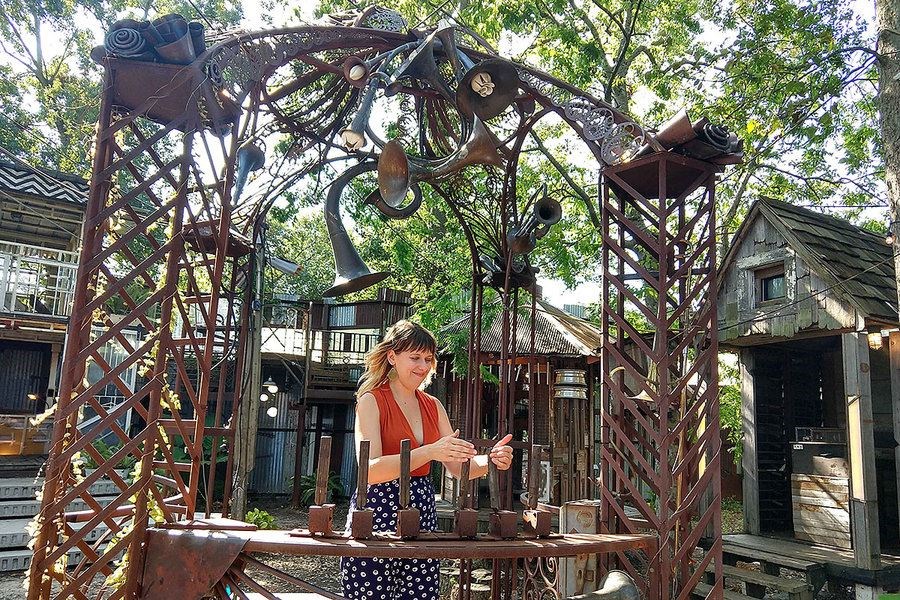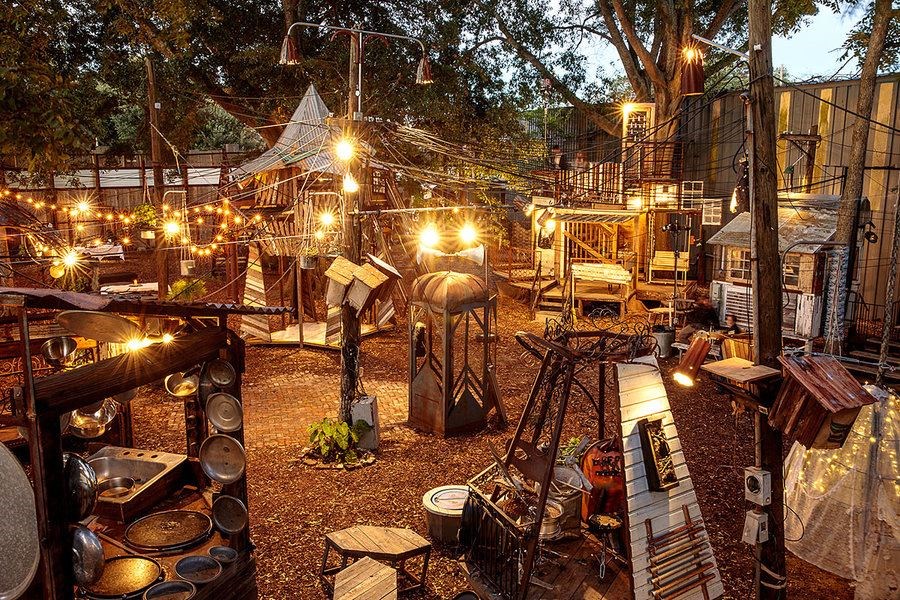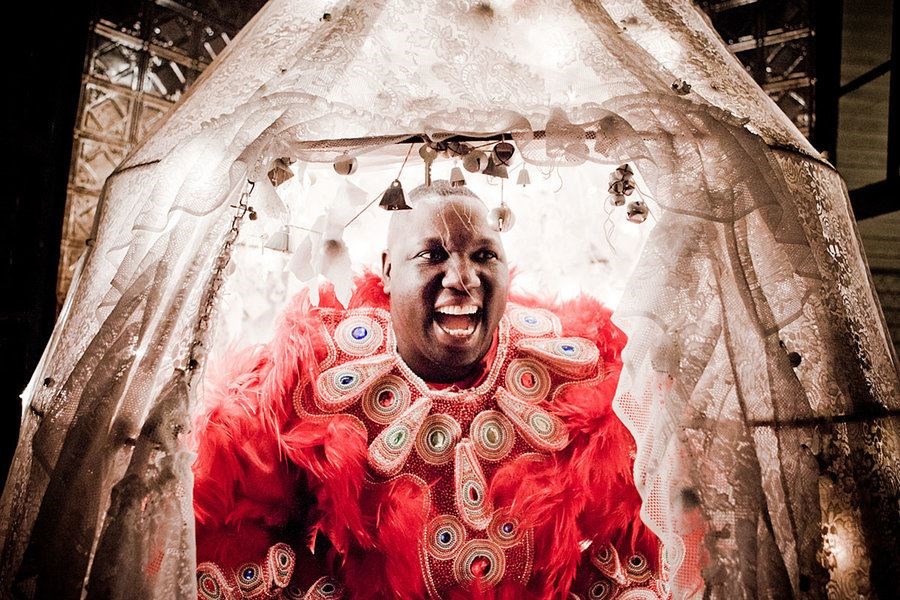Reprinted with permission from The Christian Science Monitor
After a natural disaster, how can a city’s healing be measured? The outdoor arts exhibition Music Box Village, celebrating its 10th anniversary this year, offers a model of post-Katrina resilience in New Orleans.
OCTOBER 8, 2019 - NEW ORLEANS - Leah Hennessy steps into a telephone booth in the center of the Music Box Village, a permanent outdoor arts exhibition, and lifts the receiver. There’s no dial tone. The booth is an unusual musical instrument, one of the many exhibits that Ms. Hennessy oversees as the venue’s creative producer. When she sings “You Are My Sunshine” into the mouthpiece, a horn-shaped speaker on top of the booth broadcasts her voice. The horn starts to rotate like a weather vane in a gale. In a nifty effect, it distorts Ms. Hennessy’s voice so that it warbles like a gramophone record.
 Leah Hennessy, creative director of the Music Box Village in New Orleans, pulls levers that expel compressed gas through horns on an exhibit titled “The Delphine,” created by Swoon and Darryl Reeves in collaboration with the New Orleans Master Crafts Guild.Stephen Humphries/The Christian Science Monitor
Leah Hennessy, creative director of the Music Box Village in New Orleans, pulls levers that expel compressed gas through horns on an exhibit titled “The Delphine,” created by Swoon and Darryl Reeves in collaboration with the New Orleans Master Crafts Guild.Stephen Humphries/The Christian Science Monitor
If inventor Rube Goldberg were to transform a junkyard into musical architecture, it might resemble the Music Box Village. By day, it is an interactive playground for tourists. By night, it’s a live music venue for exploratory musicians. More than that, it’s a metaphor for the extraordinary revitalization of New Orleans. On the eve of its 10th anniversary next month, the community center is a testament to the artists who had a vision of creating something beautiful from the detritus left by Hurricane Katrina – a physical representation of perseverance.
“It’s become one of the cultural institutions that I would say is on your must-see list,” says Doug MacCash, features writer for The Times-Picayune/The New Orleans Advocate. “The Music Box was literally built out of the ruins. The clapboards, and the salvaged materials, and all the found objects that went into those little structures were very familiar to us. Those were the sorts of things that were piled on the curbs from the damage.”
The Music Box Village sits next to train tracks on the industrial edge of New Orleans’ Bywater neighborhood. The village walls, a patchwork of corrugated iron strips, give it the outward appearance of a fortress straight out of “Mad Max.” Today, Delaney Martin – co-founder and artistic director of New Orleans Airlift, the parent nonprofit organization of the Music Box Village – sits outside with her drowsy baby while Ms. Hennessy demonstrates a nearby installation. She tugs on ropes that make ceiling fan-like blades and tubes spin around to generate tranquil drone sounds. Ms. Martin’s baby doesn’t stir.
The once-nomadic Music Box installation settled in this permanent location three years ago. But its genesis dates back to the aftermath of Katrina.
 Music Box Village is a permanent outdoor interactive arts exhibition in New Orleans. By day, it is an interactive playground for tourists. By night, it’s a live music venue for exploratory musicians.Tod Seelie/Courtesy of The Music Box Village
Music Box Village is a permanent outdoor interactive arts exhibition in New Orleans. By day, it is an interactive playground for tourists. By night, it’s a live music venue for exploratory musicians.Tod Seelie/Courtesy of The Music Box Village
“It was a very depressing era when there were people still stranded out of town and a lot of the old familiar sites and neighborhoods were still ruined,” recalls Mr. MacCash. “There’s a couple of wonderful things about the Music Box, and one of them was there was a great spirit of ‘we’re going to come back.’ There was a spirit of defiance.”
Airlift co-founders Jay Pennington and Ms. Martin wanted to draw audiences to the desiccated city by transforming a dilapidated Creole cottage into an artist gallery and performance space. Mr. Pennington invited the renowned New York-based mixed-media artist known as Swoon to revamp the house.
The result was an ambitious concept: Transform the house into a giant accordion – the principal instrument of Louisiana’s zydeco music. Their idea may have been sound, but the building’s structure wasn’t. It collapsed. Despite the setback, Ms. Martin envisioned an opportunity to invite 25 local artists to create small-scale variants of the musical architecture idea.
“I had this vision of a shantytown sound laboratory,” says Ms. Martin. “We had all this wood from the falling-down Creole cottage and I said, ‘OK we have this raw material. Let’s all get together and we’ll build tiny little houses that don’t cost a lot of money.’”
Some of the original installations survive in the Music Box Village. Some travel as mobile installations to other cities. No installation is alike. Inside a wooden cabin, loose floorboards trigger electronic sounds. A metallic gazebo features an array of levers that blast compressed air through brass-band horns welded into the structure’s exoskeleton. Up in a treehouse-like “drum kitchen,” percussion instruments are fashioned from pots, pans, and, well, everything including the sink.
The Music Box Village constructed a replica of its quirky phone booth for Orléans, the French twin sister town of New Orleans. It’s all part of Airlift’s mission to foster connection between communities, both local and abroad.
 Theris Valdery, of the Black Feather Mardi Gras Indian Tribe, performs at the original Music Box in 2011.Melissa Stryker/Courtesy of The Music Box Village/File
Theris Valdery, of the Black Feather Mardi Gras Indian Tribe, performs at the original Music Box in 2011.Melissa Stryker/Courtesy of The Music Box Village/File
Its latest installation, “Elevator Pitch,” arose from a 2019 partnership with the Smithsonian Asian Pacific American Center as part of their Year of Music. Co-designed by sound artist Christine Sun Kim, who is deaf, the exhibit consists of a grounded elevator in which the buttons inside next to the doors trigger shouts recorded by 13 deaf people. The vibrations approximate how deaf people experience sound.
There’s no central stage, so up to 1,000 attendees can enjoy close proximity to local performers or even notable guests such as Solange Knowles, Peaches, Norah Jones, and Sonic Youth’s Thurston Moore. Performers are encouraged to incorporate the installations into their music and, sometimes, collaborate with indigenous musicians.
Ms. Hennessy excitedly recalls how the adventurous indie rock band Animal Collective utilized many of these instruments to create new music during a memorable 2018 show.
The Music Box Village also hosts local performers as part of its mission to connect New Orleans artists. Last year, it hosted an ambitious performance by New Orleans composer Tucker Fuller, the Polymnia Quartet, and students of the Homer A. Plessy Community School. Mr. Tucker’s composition, “Ode to NOLA: A Musical Collage,” utilized boxes in the village to create musical motifs that represented the mood and feel of each of the city’s neighborhoods. Fifth and sixth grade students had to follow a conductor to know when to play the musical sculptures.
“The preliminary visit [to the village] was an entire field trip for the whole school,” says Kate Withrow, a violinist in the Polymnia Quartet, who also teaches strings at the school. “The students could just come in and tinker on the instruments to get a feel for them before we even started on the composition. [The Music Box Village] philosophy in terms of making these instruments available to students all over the city is very apparent.”
The Music Box Village has an ambitious wish list for the future, including the addition of recording facilities, Dolby surround sound, and an upper level accessible via the elevator. One day, perhaps, they’ll construct that full-scale accordion house.
“We’re hoping that we are doing something slightly new in music,” says Ms. Martin. “On a history-of-music level, the kind of spatial phonics that happen and the way we see people at our concerts and the way the music is happening all around you, we’d like to think that we are contributing something to the way music is experienced and heard.”
Page created on 10/8/2019 5:11:44 PM
Last edited 10/8/2019 5:26:07 PM
